Range Rover Vogue on long-term test: is it still the pinnacle of luxury SUVs?

Love them or hate them, there is no denying that large SUVs are here to stay. We decided to revisit the original luxury 4x4 to find out whether it merits its exalted status.
Our Car: Range Rover TDV6 Vogue
List price when new: £79,595 OTR
Price as tested: £81,985
Official fuel economy: 40.9mpg
January 15, 2019
Fuel economy this week: 32.1mpg
The Range Rover has reached the end of the road – our three-month loan period came to an abrupt halt all too soon and I’m already missing its multi-purpose ability on the driveway.
Whether it was carrying my exploding fridge to the recycling centre, ploughing out of the mud-soaked car park at Twickenham, or just reverting to being a luxury limo on the hack up the M40 to London, the ultimate Land Rover has tackled everything we’ve thrown at it with great aplomb.
Some might argue that the viability of giant off-roaders like the Range Rover is in doubt nowadays. Yet with Lamborghini, Bentley and Rolls-Royce joining the market and Aston Martin entering the fray later this year, there’s nothing to suggest SUVs are losing their appeal.
And even with Jaguar Land Rover’s current problems, the iconic status of the Range Rover means it will likely still be a favourite with the well-heeled in some shape or form 100 years from now.
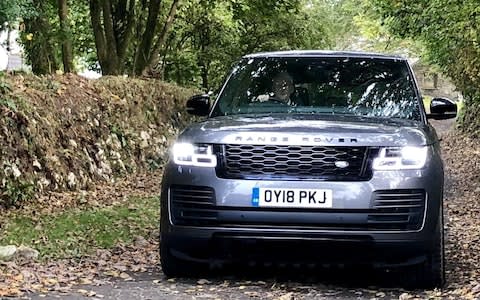
The original Range Rover was aimed squarely at the landed gentry but today, of course, it has mass appeal. You’re likely to count as many parked on a street in Mayfair as you will see in posh Chipping Norton.
The reason is that the Range Rover is more a luxury car than a mud-plugger. Not many people can afford to drive an £80,000 vehicle around the farm. However, unlike the Porsche Cayenne, Lamborghini Urus and assorted other super SUVs, the Rangey really can keep up with a tractor if required.
Our ‘entry-level’ Vogue is the cheapest Range Rover – still hugely expensive – but it didn’t leave me wanting for anything. Heated windscreen and steering wheel, rain-sensing wipers and Land Rover’s latest dual-screen dashboard are all included.

You can spend £162,000 on the SVAutobiography with a 1,700W sound system, V8 engine and mohair floormats but I would genuinely prefer our Vogue 3.0 TDV6 because it is the best all-round package for everyday use.
We’ve averaged around 31mpg yet in Sport mode it will wind up to 60mph in a creditable 7.4 seconds. But the Range Rover is so big and smooth to drive it actually feels a lot faster. Yes, it will lean into a corner but, my goodness, it’s supremely comfortable, too.
What would I change? The rear parcel shelf could be easier to remove and fit, it’s not the easiest to park in multi-storey car parks and the navigation can be sluggish but that’s about it. The latest updates for 2019 – including that double screen dash – mean this particular model still feels as fresh and appealing as when it was launched six years ago.
January 8, 2019
Fuel economy this week: 30.4mpg
Our long-term Range Rover has put in a faultless shift over the last three months, so what happened when I left it parked at Heathrow for two weeks over the Christmas period?
The festive gremlins moved in, that’s what. They drank all the washer fluid, drained the AdBlue – that clever chemical that helps reduce harmful diesel emissions but always runs out at the wrong moment – and somehow affected the sound system.
The latter was the most baffling. Pulling out of Terminal 5, I noticed the indicator wasn’t sounding the usual tick-tick, then the sat-nav refused to give voice instructions and my favourite podcast wouldn’t work.

Struggling with 9,000-miles of jetlag, I cursed the infotainment system which had left the cabin in silence. The Bluetooth sound connection to my telephone had also been cut, yet the dashboard screen was operating perfectly.
As I passed Reading on the M4 matters got really out of hand. Suddenly, my mobile gave an emergency alert warning - the kind usually reserved for impending disasters such as hurricanes and earthquakes. The only time I have ever experienced this before was driving into a major flood in New Orleans.
Then the Range Rover’s Bluetooth kicked in again and connected me to the emergency services in France! Scrabbling to remember my GCSE French, I apologised to the operator and made for the next service station.

Topped up with AdBlue and washer fluid, I spent a good half an hour trying to work out just what had gone wrong, or which button I had inadvertently pressed to send the Range Rover into such a tizzy.
The solution, as with all such technical problems involving a computer in meltdown, was to turn off the ignition, lock and then unlock the car and voila – it was all systems go again as if nothing had happened.
Now every time I get in the Range Rover, I half expect a call from the French emergency services, berating me for wasting their time. I doubt even Land Rover could explain it either but, for now at least, normal service has been resumed.
December 17, 2018
Fuel economy this week: 32mpg
The 12 days of Christmas are upon us, so here are a dozen festive reasons why our Range Rover is still the king of SUVs.
Intelligent folding seats: The back seats can be operated via a button in the luggage area. And if the front seats are too far back to allow folding space, they automatically move forward at the same time too. Just what you need to dispose of the old Christmas tree.
Touch Pro Duo: Land Rover has swept away console buttons on the latest Range Rover with two HD screens that operate most of the controls. And you don’t need to be a tech genius – it’s simpler than that PlayStation wrapped under the tree.

Off-road prowess: If Santa was choosing a suitable delivery vehicle for long journeys and go-anywhere ability, he’d swap his sleigh for one of these. Terrain Response, Trailer Stability Assist, Hill Descent Control and Low Traction Launch are all standard.
Matrix headlights: Forget fairy lights, these laser LEDs are simply brilliant. Apart from auto dip and beam, they are made up of individual segment that only dip in the area where another car is located ahead, thus giving a brighter, wider field of vision.
Infotainment: If you want to jingle all the way, the standard Meridian sound system packs enough bass and treble for that long drive home for Christmas.
Pedigree: The Range Rover is almost 50 years old. Even in its fourth generation guise, it is still instantly recognizable as a luxury icon and a very desirable gift, if you have a rich uncle.

Twin-blade sun visors: So simple you wonder why more cars don’t have a pair of visors for each front seat passengers. One for the side window, one for the screen. Very handy for winter days.
Power Gesture Tailgate: Arms loaded with Christmas presents? What Land Rover describes as a ‘smooth kick and return motion’ behind the rear wheel will open the boot automatically. Brilliant.
Laminated rear privacy glass: It is a £400 option but if you have a tendency to leave shopping and presents on the back seat, darkened glass helps keep naughty elves at bay.
Heated steering wheel: My personal favourite. After sweeping snow off the bonnet – no need to worry about the windscreen, as it’s heated – warm hands as you drive.
Follow me home lighting: There are no street lights on my farm track. Down lights under the door mirrors and headlights that stay on while I fumble for house keys are effective during winter nights.
Power-folding and heated door mirrors: As well clearing ice super-efficiently, they’re also perfect for hanging a brace of pheasants!
December 11, 2018
Fuel economy this week: 31.6mpg
There is big and then there is really big. In Britain, the Range Rover is considered a giant of a car – a nightmare to park and not exactly PC in an urban environment.
Even larger luxury SUVs exist – the Bentley Bentayga and Rolls-Royce Cullinan, for instance – but even they pale in comparison next to the outsize pick-up trucks I’ve just encountered on a four-day bicycle ride across the remoter parts of California.
Americans love the Range Rover, but over there it looks tiny. The ultimate Land Rover really needs to be genetically modified and filled with Botox if it is going to stand out in a crowd and turn heads.
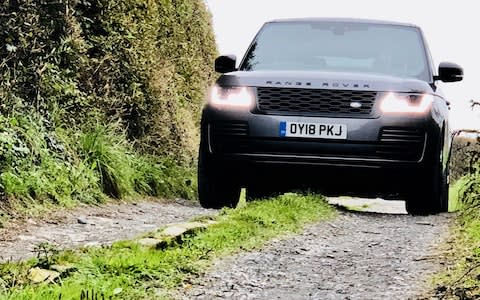
At least when it comes to parking the Range Rover has a trick up its sleeve. I’d like to think that whatever the size of vehicle I could manoeuvre into a space but, just in case, our Vogue test car not only has front and rear sensors but also the optional Park Assist system.
I don’t know anybody who admits to using an automatic parking system so I thought I’d seize the opportunity to try it at Heathrow before departing for California. Unlike the multi-storey car park I encountered in Liverpool (see my November 27 report), the long-stay at Terminal 3 is designed for vehicles larger than a supermini.
Even so, squeezing all five metres of a Range Rover into the tightest space I could find did look a challenge. Park Assist is operated via a button on the touchscreen, allowing sensors to measure up the intended slot and automatically avoid objects and other vehicles on the way in to the gap.
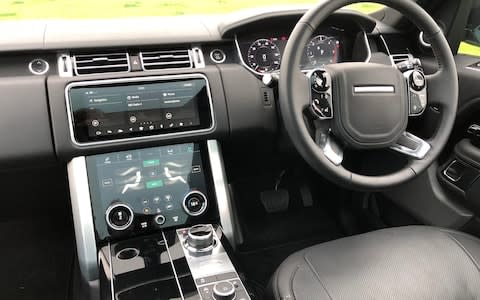
The space has to be 20 per cent bigger than your vehicle but, once the system is activated, it’s just a case of selecting reverse gear and, counter-intuitively, letting go of the steering wheel. The Range Rover does the rest.
I’ve sat in an autonomous car before as it steered itself through traffic but there is still something rather uncomfortable about relinquishing control of a moving vehicle.
In the future, worries about fitting into a tight parking space will be a thing of the past. Until then, I think using my own eyes is less nerve-wracking.
December 4, 2018
Fuel economy this week: 30.9mpg

The word iconic gets bandied about far too often but last week I ran two of the world’s most recognisable four-wheel drive vehicles side by side, as our long-term Range Rover was joined by the latest Mercedes G-Class – still best known as a G-Wagen.
It would be a disservice to brand either of these vehicles as SUVs. Both are in a class of their own when it comes to off-road ability and luxury, both are the ultimate town and country machines.
And while our V6 diesel-engined Land Rover is battered into submission by the outrageous performance of the V8 petrol-powered G 63 Mercedes – what do you expect at almost double the price? – I’m still hankering for the Range Rover.
You could argue the Mercedes targets a different audience, thanks to its utilitarian and indestructible war zone upbringing. Yet I doubt there are few places it could reach that the Range Rover couldn’t.
Not only that, revisions to the suspension of this second generation G-Wagen still leave it lagging behind for comfort. It rides more like a Jeep Wrangler than a luxury four-wheel drive costing in excess of £140,000.
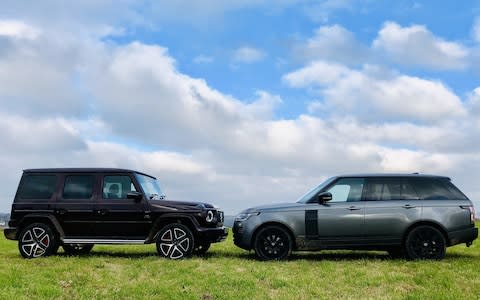
And being the centre of attention all the time can be tiresome. Drive the Range Rover and your luxurious 4x4 won’t be the backdrop for countless selfies when you are stationary in the high street.
The Range Rover has the same effect as the understated, yet rather brilliant Volkswagen Golf R. It’s a covert Mercedes G-Wagen, for people who don’t want to make a fuss, or are possibly embroiled in an extra-marital affair.
And if you really do need a giant lump of performance under the bonnet of a Range Rover, choose the 5.0-litre V8. It costs roughly the same as the Mercedes and will hurtle along at quite ridiculous speeds, too.
Which one you choose might come down to whether you want to be perceived as a member of the landed gentry, or somebody who likes to announce their arrival with an overture of exhaust and doesn’t know one end of a shotgun from the other.
Icons or not, I imagine most of us are firmly ensconced somewhere between the two.
November 27, 2018
Fuel economy this week: 30.1mpg
Our fourth generation Range Rover may be the largest incarnation of an off-road legend but it is also the most aerodynamic. Thanks to designer Gerry McGovern and his team, our test car has a relatively low drag coefficient or Cd figure of 0.34.
Considering the Range Rover is shaped like a brick, this is surprisingly good. The lower the number, the more slippery the car is through the air. By comparison, the class-leading Mercedes A-Class is a svelte 0.22 and a Tesla Model S 0.24, so the Rangey isn’t doing too badly considering its size.

It has more rear legroom than the previous generation, retains the classic ‘clamshell’ bonnet and still features the distinctive ‘floating roof’ of earlier versions. Modern, computer-aided aerodynamic technology helps but this is still highly impressive design.
Unfortunately, the modern trend to make cars larger does have drawbacks in the real world – well highlighted in a modern multi-storey car park.
Last week I had to travel to Liverpool. Searching for a parking space in any city centre can be a frustrating business but I quickly found myself being directed to a multi-storey with plenty of available spaces.
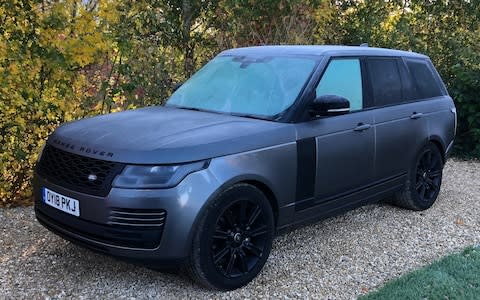
Once through the barrier, I discovered the reason why. Apart from that nervous moment when the maximum height bar passes within inches of the roof, this was a car park designed for superminis rather than SUVs.
Level by level I crept upwards, multiple paint scuffs on every ramp wall an indication of those who had dared to pass before me and failed. By the fifth floor I had a cavalcade of smaller cars behind me, holding back as I reversed to and fro negotiating each tight turn.
The Range Rover’s proximity sensors were on high alert by the time I finally shoehorned into suitable space. Sweaty-palmed, I then had to breath in to squeeze out of the door.
Car parks in Liverpool are cheaper than London but then you have to add on the cost of two lightly scuffed alloy wheels. Had this been one of the more expensive Range Rover models with even lower-profile tyres, I shiver to think of the bill.
November 20, 2018
Fuel economy this week: 32.1mpg
If in doubt, ask the dog. It may sound like the least scientific way of evaluating a car’s level of comfort but my Viszla has travelled in more than 500 different vehicles over the past 10 years.
With such wide-ranging experience, Malin would be perfectly placed to give you a view of ride quality – if he could only operate a keyboard.
Each week, we travel down the Fosse Way in the Cotswolds, curse rush hour traffic in Cirencester, avoid meandering tourists around Bourton-on-the-Water and finally negotiate a farm track.

Malin doesn’t travel well and by the time I’ve opened the boot or back door he is squeaking to escape. It’s been like that in every car since he was a puppy – except in our long-term Range Rover.
A heavy bodyshell riding on relatively high-profile tyres helps soften the bumps, but combine that with air suspension and suddenly the Range Rover is as smooth as a Rolls-Royce.
The advantages of ‘air’ are best experienced over rough ground, when adjustments to the air pressure compensates for the ruts and ridges experienced off-road. The downside is that you would expect the Range Rover to wallow and lean heavily on Tarmac.
It may not be a Porsche Cayenne in corners but the Range Rover remains surprisingly stable. And thanks to the lower weight of our V6 diesel engine over the heavier V8 model, it feels remarkably agile, too.

There are a few other factors which make the Rangey perfect for passengers who covet a comfy ride. The high seating position and large windows give excellent all-round visibility, with an imperious view over hedgerows.
The car feels well planted on the road – gliding over potholes to the extent that I thought Cotswold District Council had been hard at work filling in the worst ones under cover of the night.
This all adds up to a supremely comfortable executive car with a limousine-like ride. And if you happen to own a mutt, it’s also the dog’s doo-daas.
November 13, 2018
Fuel economy this week: 30.1mpg
To witness British culinary inventiveness, visit Twickenham stadium before a major rugby match. The Cardinal Vaughan car park nestles next to the North Stand and is unequalled in terms of homemade, pre-match hospitality.
Despite uncertain conditions underfoot and the effects of alcoholic imbibing, here you will discover a spread of food and drink to outdo anything created in the Bake-Off tent.
Top choice in this mud-splattered field of cheer is a Land Rover, with the Range Rover a firm favourite. Why? Because the bottom half of the two-section tailgate doubles as a food table, or handy picnic seat, with the top section keeping off the rain.
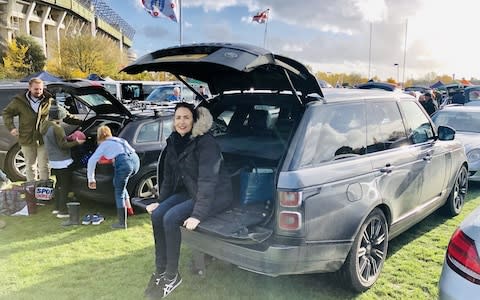
The split tailgate was always the Range Rover’s unique selling point. Others have followed and, not to be outdone, Rolls-Royce even offer a deployable, slide-out ‘viewing platform’ with the new Cullinan SUV.
Like all models in the line-up, our entry-level Vogue has an electrical tailgate. It’s not my favourite feature because firstly it’s a lot slower than doing it yourself and secondly you still need to fumble in a pocket for the keyfob as you approach with an armful of shopping.
The third reason why electric tailgates can be a pain will only affect those of you who visit a multi-storey car park with a low ceiling.
This happened to me at the Westgate shopping centre in west London. Realising an electric tailgate impact was imminent, I sprinted from the driver’s seat to the rear and narrowly avoided an expensive ‘coming together’ of metal on concrete.

I’ve already mentioned Land Rover’s InControl Remote app in an earlier report but coming out of Twickenham stadium after the New Zealand defeat, it prevented a major sense of humour failure.
In driving rain and near darkness, trying to locate the Range Rover in what had become a swamp of SUVs and spectators was proving a nightmare. Remembering the app, I switched on and used the locator to find our car.
A brilliant example of technology overcoming adversity – except when I opened the door to the Range Rover and discovered a man in the driver’s seat. By pure chance, another Corris Grey Range Rover was parked next to mine. Almost as unlikely as an England win, but I think he saw the funny side of it….
November 7, 2018
Fuel economy this week: 32.7mpg
It won’t be long before the Range Rover celebrates its 50th birthday in 2020, with the latest model more svelte than ever.
Yes, it is a whopper but with the all-aluminium monocoque body introduced in 2012, more than half a ton has been shaved off the weight. Forget whippet-like – the fourth generation model dwarfs the original – yet the Rangey feels much lighter than the sum of its parts.
Our 3.0-litre V6 diesel is the least powerful engine in the line-up, which includes a V8 diesel and three petrol engines. The new 2.0-litre PHEV 400e also cuts emissions, boosts fuel economy and reduces company car tax.
So you might think the V6 model is the least enjoyable to drive. It isn’t. There’s masses or torque, minimal engine noise and a genuine surge when required; 0-60mph in 7.5 seconds is remarkable for the size of car.

I imagined I would need the rotary transmission dial turned to ‘Sport’ most of the time, just to coax the Range Rover along. Not the case – the eight-speed automatic gearbox picks up smoothly from low revs and just keeps on going and going.
Air suspension is standard, so apart from the magic carpet ride the Range Rover stays flat and stable around a corner. My nerve would slip long before those 20-inch alloys started scrambling for grip.
And while you could rightly argue that executive rivals from Mercedes, Audi and BMW offer a more driver-focussed experience, the high seating position and go-anywhere ability of the Range Rover would make it a no-brainer - if I was lucky enough to have £80k to spend on such luxuries, of course.
I’m prepared to sacrifice a little driver involvement with the V6 because it is so exceptionally comfortable and capable in every other aspect. I find it hard to believe a car this size can perform the way it does – and I haven’t even taken it properly off-road yet.
October 31, 2018
Fuel economy this week: 33.2mpg
My father was an early adopter of the school run in the 1960s. During cold winters in the Forest of Dean, the day would start with the sound of cursing as he manually cranked the engine of an ancient Hillman Husky.
That car came with no heater or radio and absolutely nothing as exciting as a heated rear screen. The idea of a heated seat or steering wheel was pure science fiction – as likely as a man landing on the Moon.
So I wonder what he would have thought of the Land Rover InControl app, available with our Range Rover. He hardly mastered his brick-sized mobile phone, so a computerised programmer operated from a smartphone would have been an anathema.

The weather has turned cold this week so I’ve signed up to the app. Why? Because, once installed, I can pre-heat the Range Rover on my driveway to any temperature I like.
The app automatically starts the engine (doors still locked), will beep the horn and flash the lights if I’ve lost the car in a multi-storey – or even lock the car and shut the windows when I have a senior moment.
If you need to keep an eye on your mileage for expenses, every journey is logged in the system and, perhaps slightly more sinister, InControl also lets me keep a track on exactly where the car is travelling in real time.

Of course, Land Rover isn’t the first to have an app but I don’t see the point in any tech feature unless it makes your life easier. Now I don’t have to stand on the driveway to scrape off the ice, or shiver on the journey to the station.
The Range Rover is loaded with neat kit like this that I’m still discovering. The dual-screen infotainment system is new for 2018 and will require further exploration but it does away with a rash of buttons and dials that once littered the dashboard.
It means the Range Rover almost matches Volvo or Tesla for a ‘clean’ dashboard that more resembles an iPad than a motor car. Like it or not, this is the way vehicle controls are heading so we’d better get used to it.
October 24, 2018
Fuel economy this week:33.2mpg
The original Range Rover was unveiled in 1970, when buyers were often invited along to the Solihull factory for a ceremonial handover. My former neighbour Tom, now deceased, would drive down from Scotland for a slap-up lunch with one of the British Leyland directors before accepting the keys.
On his second visit, Tom was asked what improvements he would make. It was pretty obvious. He suggested a four-door configuration instead of two, an automatic gearbox rather than the existing four-speed manual – and what about some carpets instead of those utilitarian rubber mats?
All these features eventually came to pass and Tom remained a Range Rover man right up until his death 12 years ago. There’s no doubt he would have been mightily impressed with our fourth-generation model, too.
Often regarded as the definitive SUV, the Range Rover still has that aura of ‘go-anywhere’ invincibility which comes from decades of service. It might be outclassed in some areas by a Bentley Bentayga, or outperformed (on the road at least) by the new Lamborghini Urus, but I’d still choose the Land Rover product to get me home.

Misplaced trust? Well, this week I’ve glided down to Cornwall in the Range Rover – just about the perfect car for high-speed motorway use. I’ve scrabbled up a farm track without any thought for adjusting my speed, and I’ve given a 17-year-old a lesson in the basics of car control on the disused airfield at Davidstow.
Almost half a ton lighter than the third-generation model – now looking very dated despite being only six years into retirement – this current version is more efficient, considerably better to drive and blessed with some exceptional engine choices.
I thought our entry-level, 258bhp TDV6 might be the tame option compared with the larger V8 diesel. However, I can honestly say I’m more than happy with the trade-off of a 0-60mph time of 7.4 seconds and steadily improving fuel economy (33mpg from a vehicle this size is impressive). Refined and torquey are the key elements of this 3.0-litre diesel unit.
My heavy right foot has also been coaxed into a more relaxed mode, thanks to a luxurious cabin and air suspension. It feels like I’m travelling business rather than economy – although at £80,000 it’s an expensive upgrade.
October 16, 2018
Fuel economy this week: 31.3mpg
Once upon a time, if you were part of the landed gentry, you drove a Range Rover. The rest of us owned a Freelander or possibly a chugging Discovery.
Things have moved on. Range Rover ownership starts at about £30,000 for the Evoque and morphs through myriad models to this, the “proper” Range Rover that has just joined our long-term fleet.
The full-fat version is now in its fourth incarnation and still regarded as the pinnacle of luxury SUVs. Bentley, Lamborghini and Rolls-Royce have fashioned expensive rivals but the Range Rover has lost none of its cachet.
Even populating the brand with new models such as the Velar, Sport and Evoque hasn’t dented the desirability of the biggest Range Rover of them all. It’s one of the best luxury cars money can buy.
Our entry level TDV6 version is powered by a 258hp diesel engine which, I’ve already discovered, is more than just adequate. 0-60mph is dispatched in 7.5 seconds and the official fuel economy now tops 40mpg (although I doubt we will achieve anywhere near that).
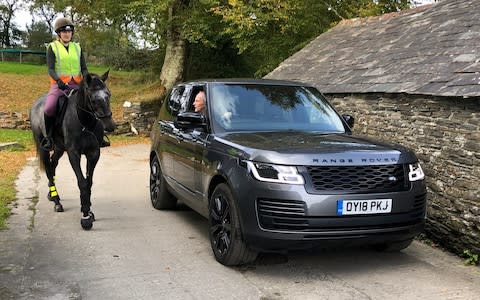
If you demand more diesel grunt, the cheapest 4.4-litre V8 is another £17,000 – roughly the same as the all-new, super-economical P400e petrol-electric PHEV version. The crazy 5.0-litre V8 petrol starts at £117,000 and is something of a dinosaur in the new, environmentally-friendly Land Rover fleet.
An eight-speed automatic gearbox is now standard on the Rangey, with a raft of adaptive driving aids for every type of condition on and off the road. These include the now ubiquitous Hill Descent Control and modes for snow, rock or whatever gruelling terrain you can find in the Cotswolds.
My farmer neighbour says a Range Rover should only be available in green but the Corris Grey of this example is a still a head-turner. Land Rover has fitted 21-inch gloss black wheels (£535) and a Black Pack (£950) to the exterior trim to add a little bling.
Those will dent my credibility at the countryside store but I’m prepared to take the flak. I’m keeping very quiet about the heated steering wheel though - it is still the best invention since cupholders.
For all the latest news, advice and reviews from Telegraph Cars, sign up to our weekly newsletter by entering your email here
To talk all things motoring with the Telegraph Cars team join the Telegraph Motoring Club Facebook group here
More long-term tests


